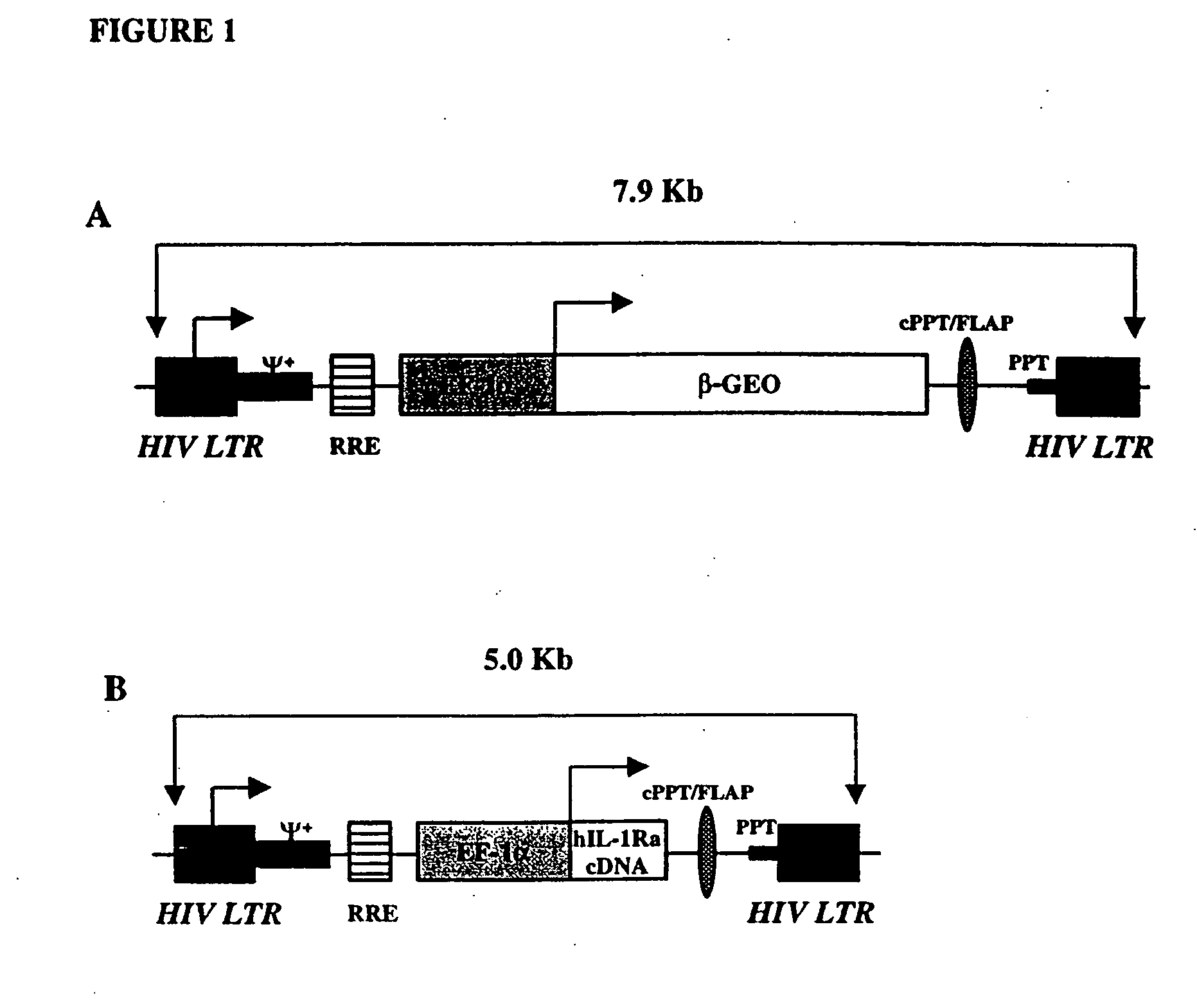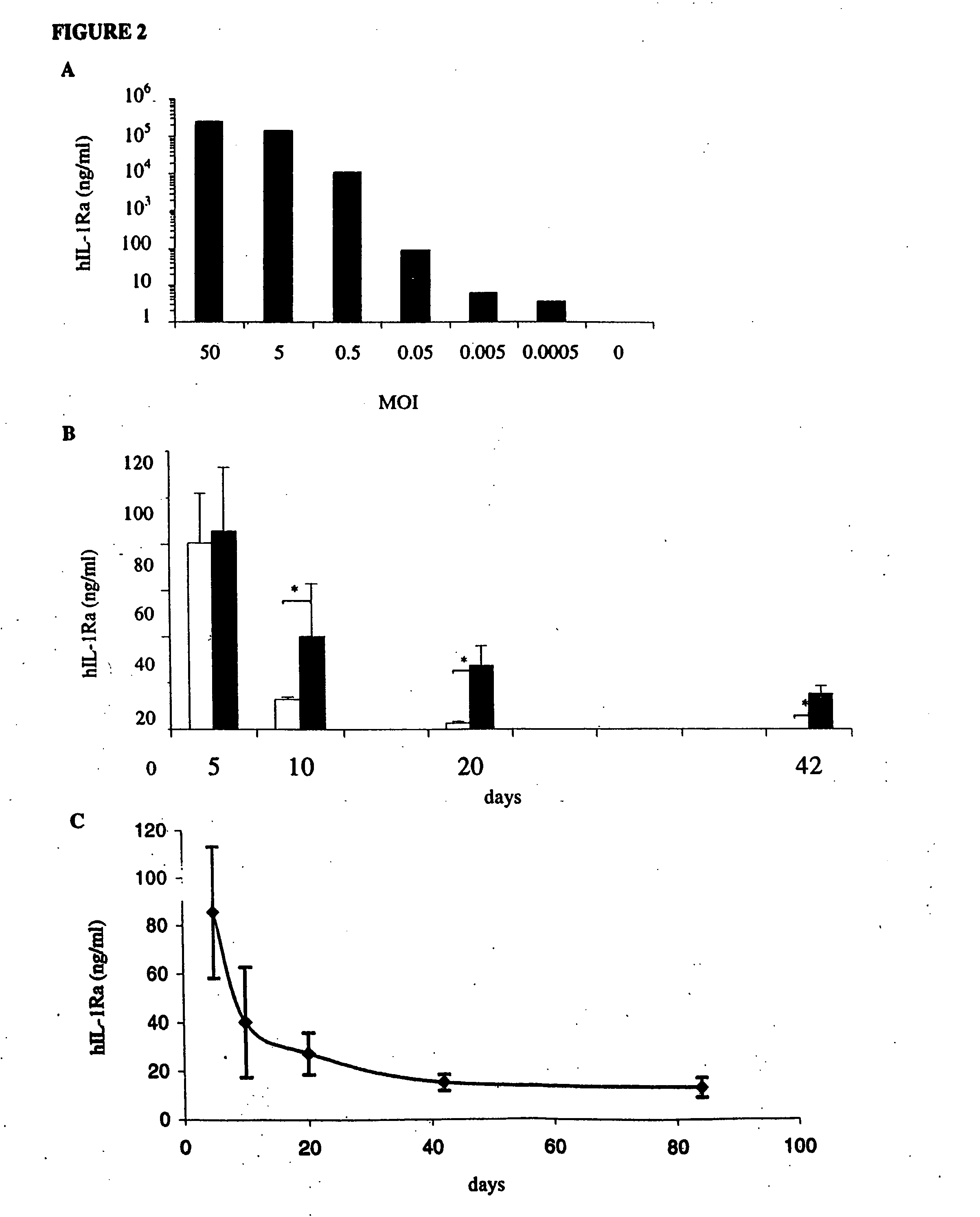Method of treating arthritis using lentiviral vectors in gene therapy
- Summary
- Abstract
- Description
- Claims
- Application Information
AI Technical Summary
Benefits of technology
Problems solved by technology
Method used
Image
Examples
examples
[0097] In the following examples high-titer VSV-G pseudotyped, HIV-1-based lentiviral vectors (FIG. 1) were evaluated for their ability to deliver exogenous genes to articular tissues in situ. These examples demonstrate that, following direct intra-articular injection, lentiviral vectors efficiently transduce synovial cells, resulting in high levels of transgene expression. Moreover, in athymic animals, intra-articular, lentivirus-mediated transgene expression is sustained for at least 42 days following delivery. These examples demonstrate that lentiviral vectors have the capacity to infect and genetically modify synovial cell cultures from a variety of species, including human, and that following intra-articular injection, they are capable of delivering exogenous genes to the joints of rats and achieving high, sustained levels of transgene expression. Furthermore, these examples demonstrate that lentiviral delivered hIL-1Ra can prevent both local and systemic sequelae of highly des...
example i
Lentivirus-Mediated Delivery of the β-GEO Gene In Vitro and In Vivo
[0106] To determine the relative efficiency with which high-titer VSV-G pseudotyped HIV-1-based lentivirus could infect and genetically modify cells from articular tissues, a battery of cell types was infected with 5×107 iu of β-GEO (β-galactosidase / neomycin resistance fusion gene) lentivirus. Primary monolayer cultures of chondrocytes and synoviocytes of human and rat origin were incubated with recombinant lentivirus at a multiplicity of infection (MOI) of 500. Forty-eight hours later, approximately 95% of cells in each culture, including human articular cells, stained positive for β-galactosidase activity. Similar levels of infection were also noted using a rabbit synovial fibroblast cell line, HIG-82, murine 3T3 cells, and primary cultures of rat skin cells. These results showed that lentivirus could indeed transduce synovial and chondrocyte cultures with reasonable efficiency in vitro and led us to evaluate its ...
example ii
Lentivirus-Mediated Delivery of the hIL-1Ra Gene In Vitro and In Vivo
[0110] To provide a quantitative assessment of the level of intra-articular expression of a secreted therapeutic transgene afforded by lentiviral vectors, a recombinant lentivirus was constructed containing human interleukin-1 receptor antagonist (hIL-1Ra). In order to characterize the lentiviral construct containing the coding sequence of the hIL-1Ra gene, 105 rat synovial cells were incubated with different amounts of recombinant lentivirus (FIG. 2A). At MOIs between 5×10−2 and 5, the amount of hIL-1Ra produced by the synovial cells increased linearly, reaching a maximum of 2.35 μg / ml at a MOI of 50.
[0111] Because of the relatively small size of the rat knee joint, sufficient volumes of synovial fluid could not be recovered by joint lavage to permit measurement of secreted transgene products by ELISA. Therefore, to determine the level of intra-articular hIL-1Ra expression, knees were harvested from rats euthani...
PUM
| Property | Measurement | Unit |
|---|---|---|
| Therapeutic | aaaaa | aaaaa |
Abstract
Description
Claims
Application Information
 Login to View More
Login to View More - R&D
- Intellectual Property
- Life Sciences
- Materials
- Tech Scout
- Unparalleled Data Quality
- Higher Quality Content
- 60% Fewer Hallucinations
Browse by: Latest US Patents, China's latest patents, Technical Efficacy Thesaurus, Application Domain, Technology Topic, Popular Technical Reports.
© 2025 PatSnap. All rights reserved.Legal|Privacy policy|Modern Slavery Act Transparency Statement|Sitemap|About US| Contact US: help@patsnap.com



